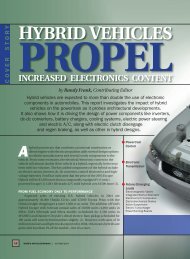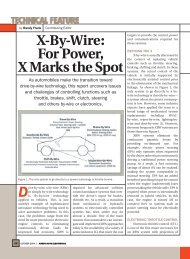the enhanced PDF version of this article - Auto Electronics Magazine
the enhanced PDF version of this article - Auto Electronics Magazine
the enhanced PDF version of this article - Auto Electronics Magazine
Create successful ePaper yourself
Turn your PDF publications into a flip-book with our unique Google optimized e-Paper software.
SPECIAL REPORT: EMERGING WIRELESS TECHNOLOGY<br />
by Randy Frank Contributing Editor<br />
EXPLORING VEHICLE-TO-VEHICLE<br />
COMMUNICATIONS AND VEHICLE<br />
INFRASTRUCTURE INTEGRATION<br />
As vehicle-to-vehicle (V2V) and vehicle-to-roadside (V2R) communication<br />
technologies evolve, one <strong>of</strong> <strong>the</strong> essential and common elements is <strong>the</strong><br />
wireless communication technique. As part <strong>of</strong> AE’s ongoing reporting <strong>of</strong> Vehicle<br />
Infrastructure Integration (VII) [1, 2, 3], <strong>this</strong> report includes <strong>the</strong> successful<br />
completion <strong>of</strong> <strong>the</strong> most recent VII Consortium milestone, <strong>the</strong> viability assessment<br />
decision, and a controversy that has arisen.<br />
The Michigan VII developmental<br />
test environment or DTE<br />
for pro<strong>of</strong> <strong>of</strong> concept (POC) <strong>of</strong><br />
several applications <strong>of</strong>fi cially started<br />
in November 2007. “However,<br />
prior to that, <strong>the</strong>re was almost two<br />
years <strong>of</strong> work going on with <strong>the</strong><br />
14 AUTO ELECTRONICS | JULY/AUGUST 2008<br />
consortium in cooperation with <strong>the</strong><br />
U.S. Department <strong>of</strong> Transportation,”<br />
Dave Henry, president, VII Consortium<br />
& senior manager, Chrysler<br />
LLC., noted.<br />
Supported by nine major OEMs<br />
(General Motors, Ford, Chrysler,<br />
Mercedes-Benz, BMW, Nissan, Volkswagen,<br />
Honda, and Toyota), <strong>the</strong> test<br />
fl eet consisted <strong>of</strong> 25 vehicles with<br />
four different makes. An On-Board<br />
Equipment (OBE) module, a 5.9 GHz<br />
Dedicated Short Range Communication<br />
(DSRC) radio with Linux<br />
Figure 1. Wireless communications between <strong>the</strong> infrastructure and o<strong>the</strong>r vehicles occur in <strong>the</strong> Dedicated Short Range Communication<br />
(DSRC) network [4] .<br />
807AESR1.indd 14 10/2/2008 4:11:51 PM
Figure 2. Consisting <strong>of</strong> more than 40 roadside equipment (RSE) units, <strong>the</strong> Michigan VII<br />
DTE public 5.9 GHz DSRC test bed with VII network has been in operation for OEM testing<br />
since November 2007 [4] .<br />
xprinc th driv<br />
automotiv.tlmatics.snsors.infotainmnt.scurity.<br />
drivers and an antenna were integrated<br />
in each vehicle with CAN<br />
access and a display. Prototype<br />
applications developed to exercise<br />
<strong>the</strong> network include probe data<br />
collection, <strong>of</strong>f-board navigation,<br />
in-vehicle signage and payment<br />
applications. Figure 1 shows <strong>the</strong><br />
VII concept.<br />
“As we were developing <strong>the</strong><br />
equipment and <strong>the</strong>n integrating <strong>the</strong><br />
equipment into <strong>the</strong> vehicles, <strong>the</strong> US<br />
DOT through its contractor Booz<br />
Allen, was also creating <strong>the</strong> RSUs or<br />
roadside units,” said Henry. “We<br />
now have equipped vehicles as well<br />
as what we call <strong>the</strong> DTE or <strong>the</strong> developmental<br />
test environment.” The<br />
DTE is basically a roadway in <strong>the</strong><br />
807AESR1.indd 15 10/2/2008 4:11:52 PM
Novi, MI area that is equipped with<br />
roadside units that cover an area<br />
<strong>of</strong> about 45 square miles and 75<br />
miles <strong>of</strong> roadway. With <strong>the</strong> DTE in<br />
Figure 3. In a cooperative collision avoidance (CCA) application, improved delay results<br />
by using a TDMA protocol with an in-band signaling technique [5] .<br />
Michigan and vehicles with <strong>the</strong> integrated<br />
equipment, in November 2007,<br />
carmakers were ready to start pro<strong>of</strong><strong>of</strong>-concept<br />
testing. Figure 2 shows <strong>the</strong><br />
location <strong>of</strong> <strong>the</strong> RSE units northwest <strong>of</strong><br />
Detroit.<br />
The executive leadership team,<br />
<strong>the</strong> decision-making body <strong>of</strong> The VII<br />
National Coalition, made up <strong>of</strong> <strong>the</strong> VII<br />
consortium that represents <strong>the</strong> automakers,<br />
<strong>the</strong> state and local departments<br />
<strong>of</strong> transportation, as well as <strong>the</strong><br />
DOT, met in May to discuss <strong>the</strong> results<br />
<strong>of</strong> <strong>the</strong> testing to date. With results and<br />
16 AUTO ELECTRONICS | JULY/AUGUST 2008<br />
a plan to move forward, Henry presented<br />
<strong>the</strong> status <strong>of</strong> <strong>the</strong> VII testing at<br />
Telematics Update 2008 [4] . “I reported<br />
that <strong>the</strong> executive leadership team<br />
did agree to continue work on <strong>the</strong> VII<br />
concept, thus passing through <strong>the</strong><br />
fi rst milestone, which was <strong>the</strong> viability<br />
assessment decision,” he said.<br />
While requesting continued investment<br />
in VII, <strong>the</strong> team proposed an<br />
accelerated effort in describing <strong>the</strong><br />
business deployment, security and<br />
governance alternatives for VII.<br />
“I think we have kind <strong>of</strong> proven<br />
<strong>the</strong> technical feasibility, although we<br />
are not done, a lot <strong>of</strong> scalability work<br />
has to be done, but I think we are<br />
proving that <strong>the</strong> concept is a viable<br />
one to pursue,” said Henry. “One <strong>of</strong><br />
<strong>the</strong> things that we have to begin a lot<br />
<strong>of</strong> good work on is <strong>the</strong> business model<br />
and infrastructure governance framework.”<br />
Next steps from <strong>the</strong> technology<br />
perspective will be more fi eld<br />
operation testing, some <strong>of</strong> it<br />
collaborative, some by individual<br />
automakers.<br />
As part <strong>of</strong> <strong>the</strong> preliminary conclusions,<br />
<strong>the</strong> cited observations and<br />
fi ndings include successfully sending<br />
and receiving vehicle “heartbeat”<br />
messages among multiple vehicles.<br />
While early tests indicate that <strong>the</strong> system<br />
supports transmission <strong>of</strong> signal<br />
phase and timing and intersection<br />
maps, message priority testing has<br />
not yet been completed. However, <strong>the</strong><br />
preliminary conclusion is that V2V<br />
safety applications can be supported.<br />
Also, pending <strong>the</strong> completion <strong>of</strong> tests<br />
to determine prioritization <strong>of</strong> safety<br />
messages, applications such as cooperative<br />
intersection collision avoidance<br />
systems can be supported.<br />
Initial fi ndings in specifi c applications<br />
include [4] :<br />
• Heartbeat messages can be exchanged<br />
between moving vehicles.<br />
• Safety link messages can be wirelessly<br />
communicated to vehicles.<br />
• Probe data can be wirelessly collected<br />
by DSRC and can be subscribed<br />
to through <strong>the</strong> network.<br />
• Signage messages can be wirelessly<br />
pushed to <strong>the</strong> vehicles and<br />
displayed.<br />
• Large fi les such as those required<br />
for Off Board Navigation can be<br />
communicated across <strong>the</strong> non-<br />
contiguous network.<br />
• Electronic payments can be conducted<br />
at speed.<br />
VII’s leadership team came to<br />
<strong>the</strong> initial conclusion that DSRC<br />
wireless communication toge<strong>the</strong>r<br />
with <strong>the</strong> POC network architecture<br />
807AESR1.indd 16 10/2/2008 4:11:53 PM
can serve diverse applications<br />
required for safety, mobility and<br />
commercial applications. However,<br />
some wireless experts believe <strong>the</strong><br />
protocol used in <strong>the</strong> current POC<br />
testing is inadequate for real-time<br />
safety — one <strong>of</strong> <strong>the</strong> major applications<br />
unique to DSRC.<br />
Avoiding Collisions<br />
While DSRC was being developed,<br />
a number <strong>of</strong> parallel efforts<br />
were being pursued by communications<br />
companies seeking to establish<br />
<strong>the</strong>ir piece <strong>of</strong> <strong>the</strong> navigation services<br />
and entertainment pie. “Purely<br />
from a technical perspective, <strong>the</strong><br />
cell phone guys are not <strong>the</strong>re to solve<br />
<strong>the</strong> safety problems,” said Subir<br />
Biswas, Associate Pr<strong>of</strong>essor and <strong>the</strong><br />
Director <strong>of</strong> <strong>the</strong> Networked Embedded<br />
and Wireless Systems Laboratory<br />
at Michigan State University. “If<br />
safety is <strong>the</strong> main concern with<br />
ultrafast message delivery, you need<br />
different protocols.” For safetyrelated<br />
systems, avoiding message<br />
collisions is key to avoiding vehicle<br />
collisions.<br />
Medium Access Control (MAC)<br />
protocols generally can be classified<br />
in two broad categories. The first is<br />
random access protocols. “The Wi-Fi<br />
protocol, 802.11, fundamentally is a<br />
random access protocol,” said<br />
Biswas. With a random access protocol,<br />
<strong>the</strong> main problem is delay or<br />
latency. When a vehicle wants to<br />
send a message and when it actually<br />
sends <strong>the</strong> message is unpredictable.<br />
Message delivery depends on <strong>the</strong><br />
behavior <strong>of</strong> o<strong>the</strong>rs.<br />
The o<strong>the</strong>r protocol is Time Division<br />
Multiple Access (TDMA), where<br />
time slots are allocated so each node<br />
gets a chance to communication in<br />
an assigned slot. This approach is<br />
predictable since <strong>the</strong>y are allocated.<br />
In contrast, in <strong>the</strong> random access<br />
protocol, <strong>the</strong> unbounded delay can<br />
occur when all nodes are trying to<br />
send in an uncoordinated manner.<br />
“It is really chaos that can happen,<br />
which is also known as a collision<br />
storm,” explained Biswas.<br />
An ideal solution does not exist<br />
today, so additional development<br />
experience <strong>the</strong> drive<br />
get <strong>the</strong> whole picture<br />
automotive.telematics.sensors.infotainment.security.<br />
electronica automotive: a unique industry ga<strong>the</strong>ring for leading international manufacturers, prominent experts<br />
and decision-makers in automotive electronics. Special highlight: <strong>the</strong> electronica automotive conference<br />
(Nov. 10–11, 2008), which focuses on <strong>the</strong> world’s latest topics and trends and <strong>the</strong> challenges <strong>of</strong> <strong>the</strong> future and<br />
promotes <strong>the</strong> transfer <strong>of</strong> know-how and networking at <strong>the</strong> highest level. www.electronica.de/automotive.<br />
Be sure to visit <strong>the</strong> concurrent trade fair www.hybridica.de<br />
German American Chamber <strong>of</strong> Commerce, Inc., Tel. (212) 974 1880, mosmers@munich-tradefairs.com<br />
electronica automotive conference<br />
Strategy + Technology + Networking<br />
www.electronica.de/automotive<br />
electronica 2008<br />
automotive<br />
23rd world’s leading trade fair<br />
New Munich Trade Fair Centre<br />
November 11–14, 2008<br />
807AESR1.indd 17 10/2/2008 4:11:53 PM
Figure 4. Within a time slot, in a self-organizing TDMA-based architecture, a ranging<br />
signal occupies <strong>the</strong> full bandwidth and following <strong>the</strong> ranging signal, <strong>the</strong> band is divided<br />
into sub-bands. Source: ACS.<br />
work is required. In a 2007 IEEE<br />
paper [5] , Biswas discusses a Vehicular<br />
Self-Organizing MAC (VeSOMAC)<br />
with an in-band signaling technique.<br />
As shown in Figure 3, in a cooperative<br />
collision avoidance (CCA) application,<br />
vehicle A sends a message alerting<br />
vehicles to slow down. The message<br />
should be forward by all vehicles<br />
across <strong>the</strong> platoon with minimum<br />
latency. The regular TDMA scheme in<br />
Figure 3b uses arbitrary slot allocation<br />
and takes three frames to reach<br />
vehicle D. In contrast, with <strong>the</strong> proposed<br />
VeSOMAC, <strong>the</strong> slots are allocated<br />
based on <strong>the</strong> vehicle’s relative<br />
location, signifi cantly reducing <strong>the</strong><br />
delivery delay.<br />
The concern goes beyond <strong>the</strong><br />
academic world. The DSRC uses carrier<br />
sense multiple access (CSMA) but<br />
<strong>the</strong> latency <strong>of</strong> CSMA is undefi ned.<br />
“For a real-time safety system, <strong>the</strong><br />
latency <strong>of</strong> that (CSMA) is too great,”<br />
said Milt Baker president and co-<br />
18 AUTO ELECTRONICS | JULY/AUGUST 2008<br />
founder <strong>of</strong> <strong>Auto</strong>motive Communications<br />
Systems, a company that has<br />
expertise in wireless communication<br />
systems. The company has a patent<br />
pending for a TDMA scheme that<br />
could solve <strong>the</strong> problem [6] .<br />
With all <strong>the</strong> testing performed in<br />
<strong>the</strong> VII test environment, <strong>the</strong> delay<br />
problem could have occurred but<br />
apparently did not. “They do not have<br />
a lot <strong>of</strong> cars running, so it is diffi cult to<br />
determine if <strong>the</strong>re will be channel<br />
interference,” countered Baker. Simply<br />
turning <strong>the</strong> message rate up will<br />
not provide <strong>the</strong> confi dence that <strong>the</strong><br />
problem will not occur. Since each car<br />
has a different back-<strong>of</strong>f time, two<br />
cars going faster does not simulate<br />
lots <strong>of</strong> cars.<br />
On a busy highway with six to<br />
eight lanes <strong>of</strong> traffi c, <strong>the</strong>oretically several<br />
hundred to a thousand cars could<br />
try to communicate with each o<strong>the</strong>r if<br />
<strong>the</strong>y are all connected to <strong>the</strong> same<br />
access point. If <strong>the</strong>re is an accident or<br />
traffi c fl ow stoppage, all vehicles<br />
may want to transmit at <strong>the</strong> same<br />
time. Figure 4 shows how an out<br />
<strong>of</strong> range vehicle can receive<br />
timely input using ACS’s TDMA<br />
architecture.<br />
Besides <strong>the</strong> contention<br />
problem, <strong>the</strong>re are two o<strong>the</strong>r<br />
problems according to Baker. VII<br />
wants to be able to resolve <strong>the</strong><br />
position <strong>of</strong> each car within one<br />
foot. “Without differential GPS,<br />
no one knows how to do that<br />
today,” said Baker. “With different<br />
GPS <strong>the</strong>re is a latency issue<br />
<strong>the</strong>re, too, because you have to<br />
calculate <strong>the</strong> GPS equations and<br />
<strong>the</strong> car is moving down <strong>the</strong> road<br />
and you get positional inaccuracy.”<br />
The third issue is <strong>the</strong> multipath<br />
problem that can occur due<br />
to <strong>the</strong> conventional modulation<br />
in today’s DSRC radios that use<br />
Orthogonal Frequency Divisional<br />
Multiplexing (OFDM). Baker noted<br />
that <strong>the</strong> telecommunications industry<br />
has essentially gone away from<br />
OFDM because it is subject to multipath.<br />
A new standard called Coded<br />
Orthogonal Frequency Division Multiplex<br />
(COFDM) is used in digital video<br />
broadcast to <strong>the</strong> handhelds in Europe,<br />
real-time video for surveillance and<br />
WiMAX.<br />
ASC believes its patent solves <strong>the</strong><br />
contention issue. “Once you solve <strong>the</strong><br />
contention issue, we believe that you<br />
can add <strong>the</strong> one foot position accuracy<br />
by using time <strong>of</strong> fl ight from <strong>the</strong><br />
cars and we believe that with <strong>the</strong><br />
COFDM modulation, those three<br />
things toge<strong>the</strong>r, you have a much better<br />
system and to our mind, it’s lower<br />
in cost than <strong>the</strong> path <strong>the</strong> industry is<br />
going down today.”<br />
Knowing how many cars are in<br />
<strong>the</strong> ring, strictly defi nes <strong>the</strong> latency in<br />
a TDMA protocol. The problem is a<br />
TDMA system requires a master to<br />
807AESR1.indd 18 10/2/2008 4:11:54 PM
determine who is going to talk. Since a<br />
master does not exist in <strong>the</strong> automotive<br />
environment, a new approach is<br />
required. ACS’s solution involves cars<br />
self-assigning time slots in a dynamic<br />
situation. The time slot is preserved so<br />
each car has its unique time to talk<br />
and <strong>the</strong> latency is defi ned. VII has a<br />
latency requirement <strong>of</strong> 100 ms. Baker<br />
insisted, “It looks to us like <strong>the</strong> system<br />
can be architected, so even with 400<br />
cars or however many cars, you can<br />
still maintain 100 ms latency and give<br />
each car an access to <strong>the</strong> channel.”<br />
The need for a time-critical bus<br />
has already been recognized by automakers<br />
for communication in<br />
onboard safety systems. CAN is not a<br />
deterministic bus, so automakers and<br />
tier one suppliers developed FlexRay,<br />
a deterministic bus developed initially<br />
for safety systems. However, to date<br />
<strong>the</strong> problem has not been observed in<br />
<strong>the</strong> VII testing.<br />
According to Baker, <strong>the</strong> process<br />
to get from patent to POC involves<br />
simulation to make sure that <strong>the</strong>y<br />
have a sound basis for proceeding.<br />
This activity is being pursued. The<br />
next step would be to create a fi eldprogrammable<br />
gate array (FPGA) to<br />
build hardware with <strong>the</strong> s<strong>of</strong>tware to<br />
provide a drop-in replacement for <strong>the</strong><br />
existing radio. Then comparison testing<br />
could be conducted by switching<br />
from <strong>the</strong> current to <strong>the</strong> proposed<br />
approach.<br />
Encouraged by <strong>the</strong> architecture<br />
disclosed in ACS’ patent, STMicroelectronics<br />
has already established a<br />
partnership with ACS. In doing so,<br />
STM supports <strong>the</strong> possibility <strong>of</strong> resolving<br />
some <strong>of</strong> <strong>the</strong> major challenges facing<br />
<strong>the</strong> VII initiative such as channel<br />
access, reliability <strong>of</strong> communications,<br />
and precision vehicle location at a<br />
much lower cost than current solutions.<br />
Based on <strong>the</strong> result <strong>of</strong> testing<br />
with an FPGA <strong>version</strong>, STMicroelectronics<br />
could investigate what it takes<br />
for a chip implementation using <strong>the</strong>ir<br />
standard cell library. Figure 5 shows<br />
<strong>the</strong> circuitry involved to implement<br />
<strong>the</strong> ACS concept, which is explained<br />
in greater detail in references [6,7] .<br />
ConTEnTion REsolUTion<br />
With all <strong>the</strong> effort that VII participants<br />
invested in <strong>the</strong> current 802.11p,<br />
<strong>the</strong> need for a bounded TDMA protocol<br />
is certainly an unpopular message<br />
— one <strong>of</strong> contention. Since DSRC is<br />
quite far along in <strong>the</strong>ir process, <strong>the</strong><br />
change from 802.11p to TDMA can be<br />
considered as a disruptive event, even<br />
though it has technical benefi t<br />
insisted MSU’s Biswas. Until <strong>the</strong>re is<br />
suffi cient testing to verify whe<strong>the</strong>r a<br />
bounded protocol is required or not,<br />
<strong>the</strong> current activity will continue.<br />
With <strong>the</strong> success experienced so far, if<br />
<strong>the</strong>re is a latency problem, it will be<br />
eventually be uncovered.<br />
References:<br />
1. “1-2-3 Red Light!,” <strong>Auto</strong> <strong>Electronics</strong><br />
Nov/Dec 2007.<br />
2. “Vehicle to Vehicle or Vehicle to<br />
Roadside Communications?,” <strong>Auto</strong><br />
<strong>Electronics</strong>, Nov/Dec 2006.<br />
3. “Making Vehicles and Highways in<br />
Intelligent,” <strong>Auto</strong> <strong>Electronics</strong>, Nov/Dec 2005.<br />
4. David Henry, “VIIC Program Progress,”<br />
presentation at Telematics Update<br />
2008, May 21, 2008.<br />
5. Fan Yu and Subir Biswas, “Self-<br />
Confi guring TDMA Protocols for<br />
Enhancing Vehicle Safety With<br />
DSRC Based Vehicle-to-Vehicle<br />
Communications,” IEEE Journal on<br />
Selected Areas in Communications, vol.<br />
25, No. 8, October 2007.<br />
6. International Publication No. WO<br />
2007/133264 A2, “Integrated Vehicular<br />
Positioning and Integrations Scheme.”<br />
7. Milt Baker and Lawrence Hill, “A<br />
Safety Communications Protocol for<br />
V2V and V2I,” <strong>Auto</strong> <strong>Electronics</strong>, July/<br />
August 2008.<br />
ABOUT THE AUTHOR<br />
Randy Frank is president <strong>of</strong> Randy<br />
Frank & Associates Ltd., a technical<br />
marketing consulting fi rm based in<br />
Scottsdale, AZ. He is an SAE and<br />
IEEE Fellow and has been involved<br />
in automotive electronics for more<br />
than 25 years. He can be reached at<br />
r.frank@ieee.org.<br />
Figure 5. The transceiver logic block diagram shows <strong>the</strong> RF and digital elements in <strong>the</strong><br />
TDMA architecture. Source: ACS.<br />
JULY/AUGUST 2008 | AUTO ELECTRONICS<br />
807AESR1.indd 19 10/2/2008 4:11:55 PM<br />
19






